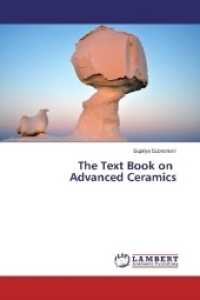- ホーム
- > 洋書
- > 英文書
- > Science / Mathematics
Full Description
t‾icrogravity research, a new field originating from the accessibility of space, has reached the age of adolescence. An impressive set of results has emerged from the fi rst Space 1 ab fl i ght, whi ch by now has been fully evaluated. In view of this and the wealth of information available from other space experiments, ground based research, and short-term microgra- vity experiments in ai rp 1 anes, rockets or fall towers, it was felt that the time was ripe for a comprehensive review of the field. The initiative of the US to build a permanent station in space, which was soon followed by a European decision to join this venture, further focussed attention onto microgravity materials sciences. This originates from the interesting prospects of a commercial space uti 1 ization, which would heavily rely on the results of scientific or technical experiments in space. From this point of view it also seemed timely and essential to provi de prospective commerci a 1 users with the necessary i nformat i on on previous experience, and more importantly, with a sound scientific basis for space processing.
The aim of the present volume consequently is twofold, namely - to stimulate new scientific experiments in space in order to expand our knowledge gained from microgravity research, and to provide industry with the information obtained from space experi- ments sofar and to contribute to the scientific background for commer- cial space utilization.
Contents
I: Microgravity Materials Sciences.- 1 Introduction.- 2. Historical Development.- 3. Stimulation of Weightlessness.- II: Physical Phenomena.- 4. Convectionon and Bulk Transport.- 5. Diffusion and Atomic Transport.- 6. Capillarity and Wetting.- 7. Solidification.- 8. Nucleation and Undercooling.- 9. Critical Phenomena.- III: Experimental Hardware.- 10. Funmices.- 11. Fluid Experiments.- 12. Containerless Processing Technologh.- IV: Case Studies and Results.- 13. Metals and Composites.- 14. Binary, Systems with, Miscibility, gap in the Liquid State.- 15. Crystal Growth.- 16. Fluid Dynamics.- 17. Themophysical Properties.- 18. Glasses.- 19. Separation Techniques.








